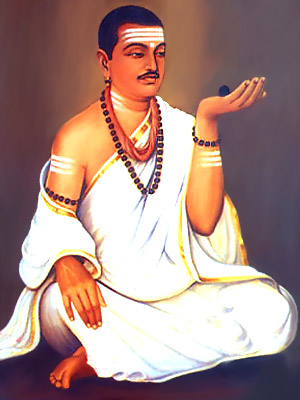 Veerashaivism rejects the authority of Vedas. The Kannada vachanas which are the religious lyrics in free verse are the most important texts of Veerashaivism. They do not recognise the supremacy of the Brahmins. Prohibition of child-marriage, allowing widows to remarry, burial instead of cremation, and the abolition of the chief Hindu rites for the removal of ceremonial impurity are followed by the Veershaivas. Each family has its own spiritual guide for the astavarna, eightfold sacrament.
Veerashaivism rejects the authority of Vedas. The Kannada vachanas which are the religious lyrics in free verse are the most important texts of Veerashaivism. They do not recognise the supremacy of the Brahmins. Prohibition of child-marriage, allowing widows to remarry, burial instead of cremation, and the abolition of the chief Hindu rites for the removal of ceremonial impurity are followed by the Veershaivas. Each family has its own spiritual guide for the astavarna, eightfold sacrament.
The spirit of Virashaivism is the disagreement between sthavara, the standing, and jangama, the moving. Ahimsa and vegetarianism are followed.
History of Veerashaivism
The early history is obscure but it is clear that they appeared as a reformist Shaiva sect in the middle or end of the twelfth century on the borders of Maharashtra and Karnataka. This sect was a reaction of the Dravidians against Brahmanic domination. Basava is considered as the founder of Veerashaivism but the books in Kannada and Sanskrit on Veerashaivism do not name him as the founder. Ekanta Ramayya is also another reformer who has been mentioned. Both leaders were involved in persecuting the Jains.
Five seats of the five founders, the panchacharya, were established close to each other. A hierarchy of matha descends from these five main matha down to the small village matha.
Symbols of Veerashaivism
Lingam, a form of Lord Shiva, worn around the neck or on the upper arm in a silver casket is one of the major symbols of Veerashaivism. The guru of the family claims descent from the panchacharya. He binds the linga on the child and it is covered with vibhuti. A necklace of rudraksha is tied around the neck and teaches the mantra which is an obeisance to Lord Shiva. The child is presented to Lord Shiva in the form of a Jangama. The Jangama is fed and the prasad is given to the child. When the child reaches the age of eight or ten then a somewhat different ceremony is repeated.
A personal linga is called the ishtalinga and the rite of its worship is a simple meditation in a household shrine. Jangama`s visit to home is a sacred event. His foot is washed by the head of the household and this water is sprinkled over the people present. The toes of the Jangama are adorned with vibhuti and patri leaves. Water or coconut milk is poured over the toes and collected as karunaprasada which the Jangama and the devotee drink.
In the initiation rite of Jangama boys and in the marriage rite of all Virashaivas, the five panchacharya pitha, are symbolized by five metal pots filled with water and betel leaves. The pattadevaru Jangamas sit on a throne wearing gold, whereas the ascetic Jangamas sit on the skin of a wild tiger.
Panchacharas
The Panchacharas describe the five modes of conduct that is to be followed:
Lingachara - daily worship of the personal Shiva Linga
Sadachara - attention to vocation and duty
Sivachara - acknowledging Shiva as the one God and equality among members
Bhrityachara - humanity towards all creatures
Ganachara - defence of the community and its tenets
Shatsthala
Shatsthala is the concept of six phases that is pivotal to the Lingayat philosophy. Through this a soul advances in its ultimate quest of realisation of the Supreme. The Shatsthala consists of Bhakta Sthala, Maheshwara Sthala, Prasadi Sthala, Pranalingi Sthala, Sharana Sthala and the Aikya Sthala. The Aikya Sthala is the stage where the soul leaves the physical body and merges with the ultimate.
Lingadharane
Lingadharane is an initiation ceremony of Lingayats. This is performed when a foetus in the womb is 7-8 months old. The family Guru provides the instalinga to the mother, who then ties it to her own instalinga till the child is born. When the child attains the age of 8-11 years, he or she receives Diksha from the family Guru. The child wears the Linga throughout and it is worshipped as a personal Ishtalinga. It is to be worn on the chest
Both men and women participate in these ceremonies in the presence of a guru.
Basava and Nandikesvara is an important symbol, especially with the virakta matha. He is found on the prakara at Srisailam. The Srisailam Mallikarjuna Temple in Andhra Pradesh is one of the five centres of the panchacharya.
Most Virashaivas live in Karnataka, Andhra Pradesh, northern Tamil Nadu, and at the Virashaiva matha in the Himalayas and at Varanasi. The head matha of the pancacharya are at Kedar in the Himalayas, Varanasi, Srisailam in Andhra Pradesh and at Ujjini and Rambhapuri in Karnataka.
The festivals celebrated by Lingayats are Akkamahadhevi Jayanthi, Allama Prabhu Jayanthi, Channa Basaveshwara Jayanthi, Channa Unnime, Shravana Masa.




















